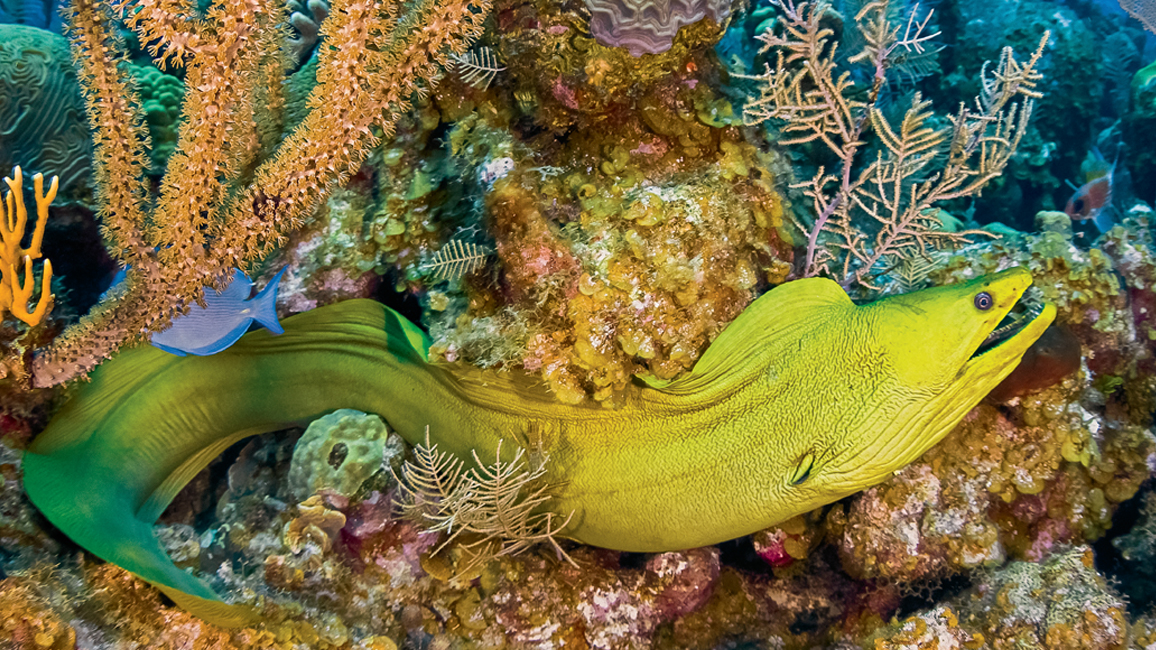
Eels: The Real Deal
By Kathy KrankingNot every long, snaky fish is an eel. Find out which ones are the real deal—and which look eely, but aren’t, really.
What do you think of when you hear the word “eel”? A moray like the one above, perhaps? Or maybe the famous electric eel? Well, you’re spot-on with the moray, but—spoiler alert!—the electric eel isn’t an eel at all. Shocking!
It can be tricky trying to tell if an “eel” is the real deal or not. But most real eels pass the “fin and skin” tests. A real eel has a long fin that runs along the top of its body and wraps around its tail. It may also have very small fins at the sides of its head or none at all. And a real eel has either no scales or small scales that are mostly buried in its skin. If a fish passes these tests, it’s probably an eel.
EELS ALL AROUND
There are more than 800 species of eels wriggling through waters around the world. Most live in the ocean, but some kinds live in rivers and other freshwater places. Eels can be as short as an adult’s pinky or longer than a car. Many are brown or gray, but the ones that live in coral reefs often have bright colors and patterns.
EEL MEALS
Eels are hunters and have lots of sharp teeth. Their long, thin bodies are great for slithering among rocks and coral looking for prey. They eat different kinds, including fish, crabs, shrimp, worms, and even other eels. Many eels hunt at night. During the day, they bury themselves in mud or hide in spaces among coral or rocks.
GROUP LIVING
Eels usually hang out alone, though sometimes they’ll share space among rocks or coral. But garden eels are different. They live together in big groups that may have hundreds of eels. Garden eels use their tails to dig burrows in the sand. Then, with their tails still in the burrows, they extend their bodies to feed on food bits that float by.
MARATHON SWIMMERS
All eels, no matter where they live, lay their eggs in the ocean. For freshwater eels, that can mean traveling thousands of miles.
When eels first hatch from their eggs, they’re see-through and tiny. They spend months just floating along in the ocean, eating tiny bits of drifting food.
When the time is right, young ocean eels settle to the sea floor to grow into adults. But young freshwater eels have lots of work ahead of them.
Freshwater eels have to migrate back to fresh water, making their way up rivers and streams. They’ll even leave the water sometimes to slither over rocks, mud, or grass! (Freshwater eels can breathe through their skin as well as through gills.) Many years later, these eels will return to the ocean to lay their own eggs.
EELY, BUT NOT REALLY
Now that you’ve met some real eels, meet some eely imposters.
WOLF EEL
Even though it has “eel” in its name and has a long body fin like an eel’s, the wolf eel is actually a member of the wolffish family. One way you can tell it’s not a real eel is by the big fin on each side of its head. Eels have very small fins or no fins there. This fish is known for its big appetite. An adult wolf eel may eat more than 20 crabs in a day.
SEA LAMPREY
Long, snaky lampreys have been around since before the dinosaurs lived. Instead of having jaws, as eels do, a lamprey has a sucking disc full of teeth. A hungry lamprey will attach its mouth to a fish, feeding on its blood and other fluids. A lamprey can stay attached for weeks, eventually killing smaller fish!
BANDED SEA KRAIT
The banded sea krait is not a fish at all but a kind of snake—one that swims in the ocean. This krait is famous for its strong venom, which is 10 times more poisonous than rattlesnake venom.
ELECTRIC EEL
The electric eel is an amazing fish. It gives off electricity to stun prey or ward off predators. Real eels can’t do that. Electric eels are different from eels in other ways, too. For example, they have no teeth, and they lay their eggs in fresh water. They belong to a group of fish called knife fishes.
So there you have it—real eels and not-so-real eels. Now you’re a “reel” expert!
“Eels: The Real Deal” originally appeared in the March 2016 issue of Ranger Rick magazine.
(Click on each image above for a closer view of the story.)




















